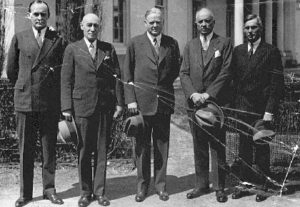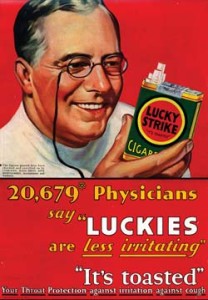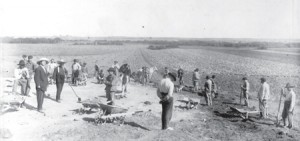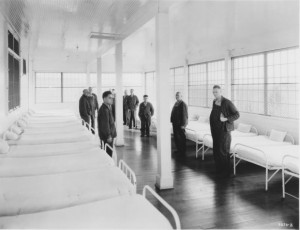When Dr. John Maurice Grimes inspected mental institutions in the U.S. (see last two posts), he discovered that the federal asylum in Washington, DC, (St. Elizabeths) was overcrowded. Continue reading
Tag Archives: Dr. John Maurice Grimes
The Truth Not Welcome
In January, 1931, the Board of Trustees of the American Medical Association appropriated $20,000 for the study of all institutions “caring for either the mentally ill or the mentally deficient of the United States.”
Small Hospitals Not Always at a Disadvantage

President Herbert Hoover, General Hines and Staff, Following the Signing of Executive Order Creating the Veterans Administration, courtesy U.S. Veterans Administration
One reason that Dr. Hummer pinched pennies at the Canton Asylum for Insane Indians was because his per capita costs were so high. Most experts at the time felt that no asylum with fewer than 500 patients could be run efficiently, and Hummer didn’t reach a fifth of that number at his very fullest. However, Dr. John Grimes (see last post) found that government veterans hospitals were being run quite well. The country had about 20 VA hospitals, which were usually established with ample space on grounds which were beautifully kept.
“Overcrowding is not permitted,” said Grimes. “Space originally provided for other purposes is not transformed into dormitories.” He also found that dormitory buildings on many hospital grounds housed 50 patients or fewer (though the hospitals themselves had several hundred patients). The furnishings were comfortable, and patients had plenty of space, with “provisions for reclining, sitting, walking, and playing, much more ample than in other hospitals publicly maintained.” Grimes saw that painting and decorating in the VA hospitals were very nice; decorations weren’t cheap and “by no means limited to the products of the departments of occupational therapy.”
Grimes’ findings show that government hospitals could be well kept, with adequate staff and the many niceties that made long-term care comfortable. At the Canton Asylum, Dr. Hummer removed all pictures and decorations because patients sometimes pulled them down to use as weapons in their fights–never thinking to attach them permanently to the walls.
Patient Susan Wishecoby pointed out an even sadder failure: “They call this an Indian Asylum and then why don’t the Indians have it more like their home?”

Civil War Veterans Receiving Care at National Bath Branch of the Soldiers Home, courtesy U.S. Department of Veterans Affairs
______________________________________________________________________________________
Unflattering Views on Mental Health Care
Over a two year period beginning in 1931, Dr. John Maurice Grimes inspected all U.S. institutions caring for the mentally ill. This was done at the request of the American Medical Association. Grimes’ report was so unflattering that he ended up publishing it himself after the AMA withdrew its support. One of the dismaying situations he discovered was how chronic most hospital stays had become. Patients no longer came under care to get well, but to get out of the way of their families.
“The average length of stay of a patient in a state hospital is measured in years,” wrote Grimes. “A patient remaining in a hospital for such a period is not under medical treatment; he is not even under medical observation. …Many of these patients have been practically forgotten by their relatives, and the hospital has made little or no effort to prevent that forgetting or to freshen and strengthen the sense of family obligation.”
Grimes suggested an increase in the number of social workers available to oversee trial “paroles” for patients. The practice of parole or furlough (another common term for visits home) had been adopted by many forward-thinking psychiatrists at the time. The practice served to free up physician time and attention for other patients, and to help the furloughed patient begin to transition back to normalcy. The practice wasn’t as widely adopted as it might have been, because there weren’t enough social workers to help with the process. In some cases, families didn’t really want the burden of caring for their family member again.
At the Canton Asylum for Insane Indians, Dr. Harry Hummer refused to give furloughs. If he thought a patient might relapse, he saw no sense in sending the person home. Unfortunately, there were few cases in which Hummer had complete confidence that a patient had been cured. Though a few patients were discharged, the majority of patients under his care were never allowed home even for short visits. This practice made their homesickness and loneliness much worse.
______________________________________________________________________________________





